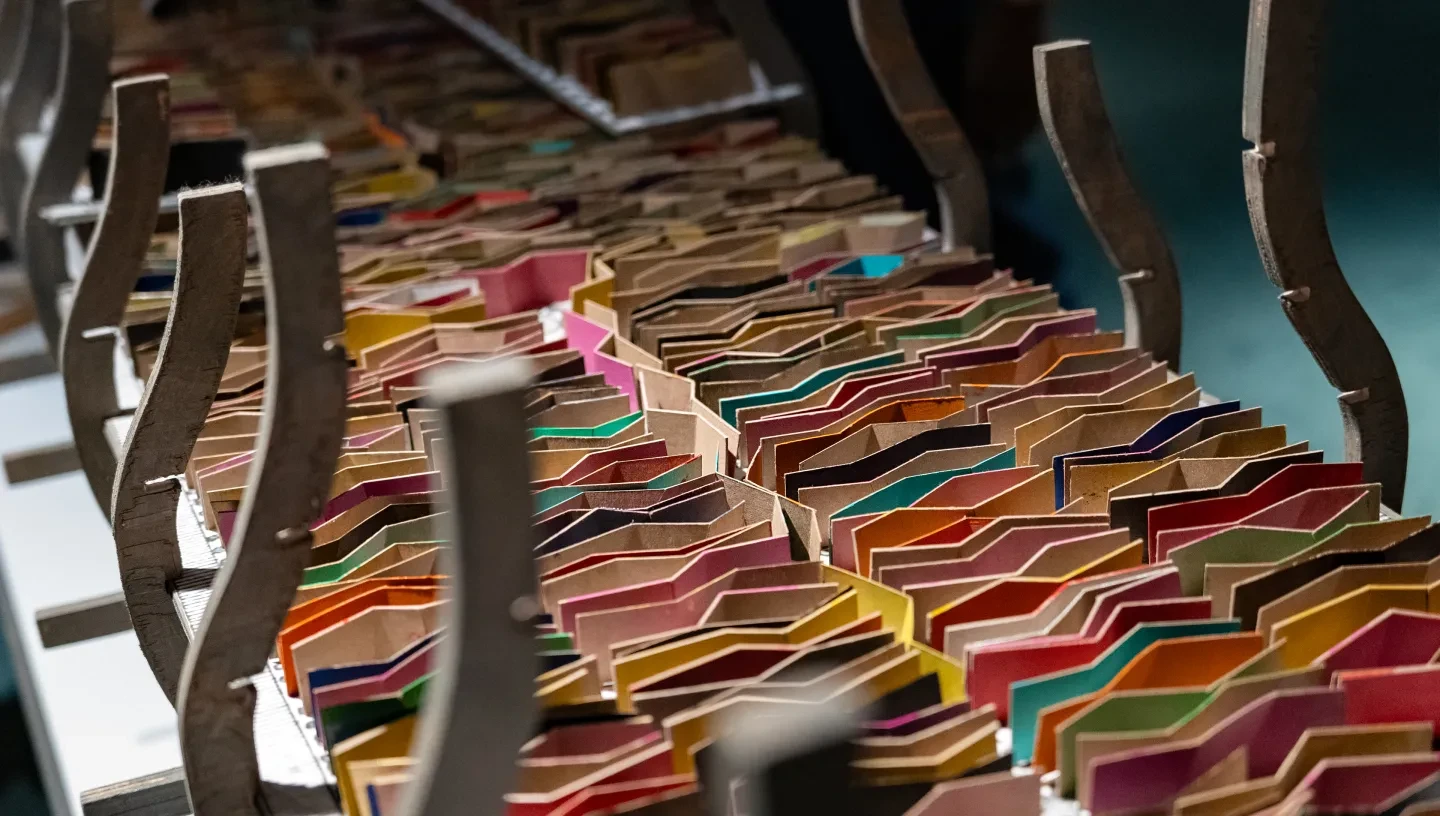
A large wooden model of a ship sits inside a display case. Within the ship’s exposed hull, 740 carefully folded cardboard markers create a zigzag pattern. The effect is colourful – and claustrophobic.
This is Brookes (Revisited), an installation in the Atlantic Worlds gallery at the National Maritime Museum that melds art, history, archival information and architecture.
The artwork is a response to an 18th century diagram called ‘Stowage of the British Slave Ship Brookes Under the Regulated Slave Trade Act of 1788’.
The original illustration was designed to show the horrific conditions on board slaving vessels under the Regulated Slave Trade Act of 1788. Brookes (Revisited) gives three-dimensional form and colour to the historic document.
The 740 cardboard ‘memory markers’ each represent in zigzag form an individual held on board the slave ship Brooks (also known as Brookes) during its third voyage in 1785.
The artwork was created by Elgin Cleckley, Associate Professor of Architecture at the University of Virginia, and his design practice _mpathic design, in collaboration with Iana Ishrat, Ben Edlavitch and Alex Fry.
See Brookes (Revisited) for free at the National Maritime Museum, and read on to learn more about the artwork and its making.
"This is not just Black history; it’s all of our history"
For Cleckley, it was important that the installation humanised the original Brooks slave ship drawing.
The individuals on board – Cleckley calls them ‘ancestors’ – were stolen and purchased from the Gold Coast, Cape Coast Castle and Anomabu (located in modern-day Ghana). They were forcibly transported during a brutal 43-day crossing of the Atlantic Ocean, and landed at Kingston in Jamaica.
“When visitors look at the installation, they’ll see that there’s a zigzag pattern that represents each ancestor,” Cleckley says.
A note in the upper right corner of the original document details how individuals would be locked ‘spoonwise […] within the distended leg of the other.’
Cleckley’s work urges us to confront the reality of that description, with each memory marker folded to represent a person’s head-to-hip, hip-to-knee and knee-to-foot. “The abstraction helps you realise how cramped, how compressed and how intense it was on the ship,” Cleckley says.
In developing the memory markers themselves, Cleckley was inspired by the vibrant hues of West African and African diaspora fabrics. He explains that the colours used in the artwork all have special meaning.
“Each colour references a human life – it brings humanity,” he says. “Colours are how we express our identity to the world.”
Both the colours and the abstract shapes, Cleckley suggests, also allow us to think beyond the confines of the ship towards the individual lives of the people on board.
“When you look at the piece, it opens you up to think about those untold narratives. Is the colour green matched to someone’s life in Africa before being captured, which has now, generationally, become someone’s life in the Americas or the Caribbean?
“You start to ask yourself these questions, but it also respects who you are and where you’re from,” he adds. “This is not just Black history; it’s global history. It’s all of our history.”
The Brooks slave ship drawing was originally commissioned by abolitionists to raise awareness of the inhumanity of forced transportation and enslavement.
“The abolitionists used new techniques to tell their story in the original drawing,” Cleckley says. “Perhaps works like Brookes (Revisited) can offer a new way to think about the images we’ve seen associated with the slave trade.” He adds: “It’s important for people to look at works like this, and think about how to develop their own ways to create and use art to tell untold stories.”
Atlantic Worlds Reimagined
Brookes (Revisited) is one of a number of contemporary art installations within the Atlantic Worlds gallery. Together they are intended to offer fresh perspectives on transatlantic slavery, as well as confront how Black histories have been approached within the space in the past.
“We’re really honoured to have this work here at the National Maritime Museum,” Cleckley says. “Brookes (Revisited) can open us up to think about the other works that are in this space – and in the Museum – in deeper ways. Perhaps it’s a way to open conversations with people on these very complex topics.”









